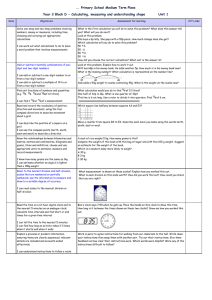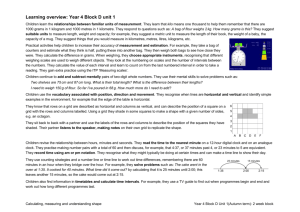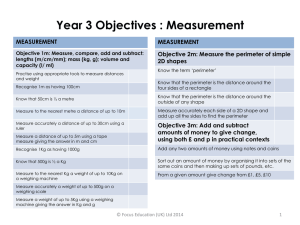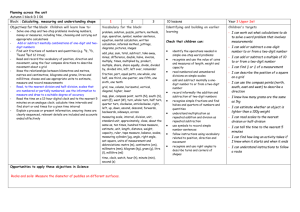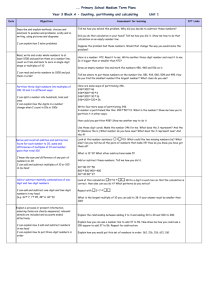Year 3 Block D - Calculating, measuring and understanding shape
advertisement
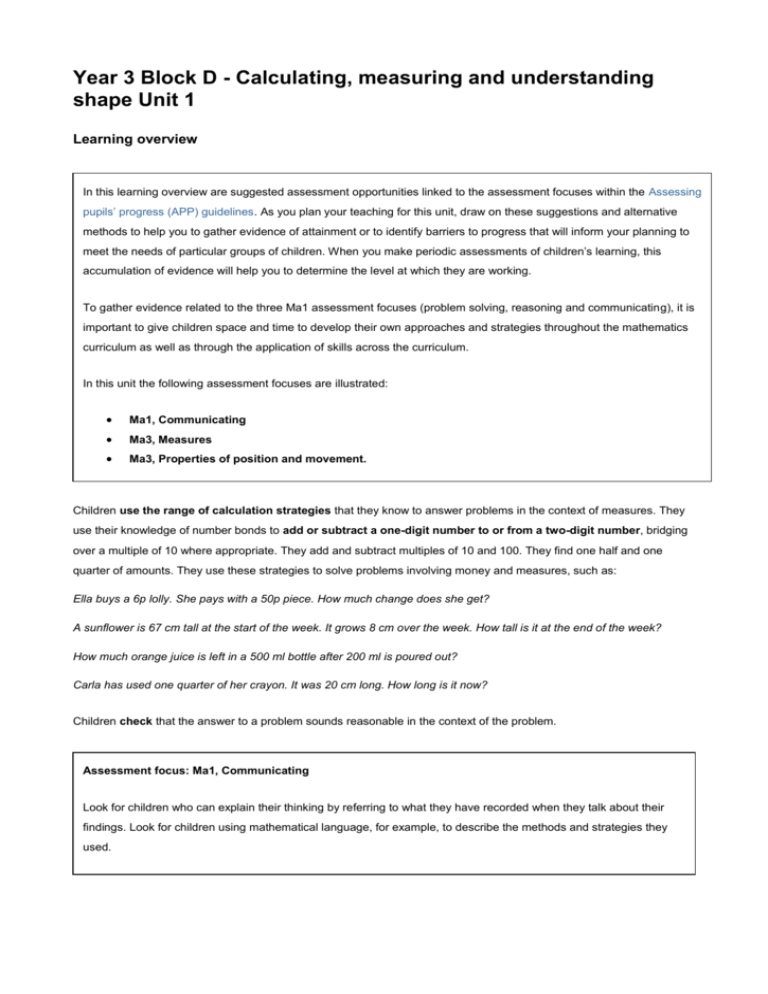
Year 3 Block D - Calculating, measuring and understanding shape Unit 1 Learning overview In this learning overview are suggested assessment opportunities linked to the assessment focuses within the Assessing pupils’ progress (APP) guidelines. As you plan your teaching for this unit, draw on these suggestions and alternative methods to help you to gather evidence of attainment or to identify barriers to progress that will inform your planning to meet the needs of particular groups of children. When you make periodic assessments of children’s learning, this accumulation of evidence will help you to determine the level at which they are working. To gather evidence related to the three Ma1 assessment focuses (problem solving, reasoning and communicating), it is important to give children space and time to develop their own approaches and strategies throughout the mathematics curriculum as well as through the application of skills across the curriculum. In this unit the following assessment focuses are illustrated: Ma1, Communicating Ma3, Measures Ma3, Properties of position and movement. Children use the range of calculation strategies that they know to answer problems in the context of measures. They use their knowledge of number bonds to add or subtract a one-digit number to or from a two-digit number, bridging over a multiple of 10 where appropriate. They add and subtract multiples of 10 and 100. They find one half and one quarter of amounts. They use these strategies to solve problems involving money and measures, such as: Ella buys a 6p lolly. She pays with a 50p piece. How much change does she get? A sunflower is 67 cm tall at the start of the week. It grows 8 cm over the week. How tall is it at the end of the week? How much orange juice is left in a 500 ml bottle after 200 ml is poured out? Carla has used one quarter of her crayon. It was 20 cm long. How long is it now? Children check that the answer to a problem sounds reasonable in the context of the problem. Assessment focus: Ma1, Communicating Look for children who can explain their thinking by referring to what they have recorded when they talk about their findings. Look for children using mathematical language, for example, to describe the methods and strategies they used. Children recognise patterns of similar calculations, such as 25 + 20 = 45, 45 + 20 = 65, 65 + 20 = 85. They continue the sequence and suggest other sequences of calculations that follow similar patterns. They apply these skills, for example when counting 20 g weights onto a balance scale in order to find the mass of an object. Children know the relationships between standard units of measure; for example, they know that 1 kg is the same as 1000 g. Children increase their experience of measures through practical activities such as finding objects that weigh about 1 kg or weighing and comparing 100 g of various materials. Children suggest suitable units and measuring equipment to estimate or measure length, mass or capacity. They explain why they think an estimate is reasonable, for example by comparing an estimated weight with a known one such as a 1 kg bag of sugar. Children relate their experience of number lines to reading scales. They use a numbered interval to calculate the value of each division on a scale and check that they are right by counting along the divisions. They use these skills to read a scale to the nearest marked division or half-division when they are measuring, for example weighing ingredients for a recipe or ordering three objects by weighing them. Assessment focus: Ma3, Measures Look for evidence that children know which measuring equipment to select to measure mass and can read a simple scale. Look for children who make reasonable estimates and adjust them in light of their experience. For example, if they estimate the weight of a book and then compare this to a 100 g weight, look for children who can check and adjust their estimate appropriately. Children know the relationships between seconds, minutes, hours and days. They read the time on a 12-hour digital clock and on an analogue clock to the nearest 5 minutes. They use counting strategies to work out simple time differences. For example, to find the length of Joy's journey to school if she leaves home at 8:40 and arrives at school at 9:05, children count on in 5-minute intervals using a clock face. Alternatively, they may use the fact that there are 60 minutes in an hour to bridge over the hour, recording their working using informal recording such as a timeline. Children use, read and record the vocabulary associated with position, direction and movement. They describe and find the position of a square on a grid with the rows and columns labelled; for example, they play "Battleships". They secretly create a simple picture by colouring squares on the grid then describe to their partner how to create an identical picture. They use compass points and other directional language to follow and describe a route, for example around a maze or grid marked out on the playground. They interpret and describe both the direction of travel and the distance for each section of the route. Assessment focus: Ma3, Properties of position and movement Look for the types of instructions children give, for example, distinguishing between straight and turning movements and using instructions such as forward, back, left, right, clockwise, anti-clockwise. Look for children giving instructions about how far to move or turn, for example, using a number of paces, quarter-turn, half-turn or 90º. Objectives End-of-year expectations (key objectives) are emphasised and highlighted Children's learning outcomes are emphasised Assessment for learning Solve one-step and two-step problems involving numbers, money or measures, including time, choosing and carrying out appropriate calculations What is the first calculation you will do to solve this problem? What does this answer tell you? What will you do next? Look at this problem. Ella buys a 6p lolly. She pays with a 50p piece. How much change does she get? Which calculation will you do to solve this problem? 50 + 6 50 – 6 50 × 6 50 ÷ 6 How did you choose the correct calculation? What unit is the answer in? I can work out what calculations to do to solve a word problem that involves measurements Add or subtract mentally combinations of one-digit and two-digit numbers I can add or subtract a one-digit number to or from a twodigit number I can add or subtract a multiple of 10 to or from a two-digit number Find unit fractions of numbers and quantities (e.g. 1/2, 1/3, 1/4 and 1/6 of 12 litres) I can find 1 1/2 or 1/4 of a measurement Read and record the vocabulary of position, direction and movement, using the four compass directions to describe movement about a grid Look at this problem. Explain how to work it out. Wilf has 68p in his money bank. He adds another 5p. How much is in his money bank now? What is the missing number? What calculation is represented on the number line? Sam adds a 50 g weight to scales containing 45 g. What is the weight on the scales now? What calculation would you do to find 1/4of 12 litres? One half of 32p is 16p. What is one quarter of 32p? This line is 6 cm long. Use a ruler to divide it into quarters. Find 1/4 of 6 cm. Which square lies halfway between squares A3 and E3? I can describe the position of a square on a grid I can use the compass points (north, south, east and west) to describe a direction Move a counter from square B4 to E2. Describe each move you make using the words north, south, east or west. Know the relationships between kilometres and metres, metres and centimetres, kilograms and grams, litres and millilitres; choose and use appropriate units to estimate, measure and record measurements A sack of rice weighs 5 kg. How many grams is this? Compare the weight of this book with this bag of sugar and with this 100 g weight. Suggest an estimate for the weight of the book. Which is a newborn baby more likely to weigh? A 30 g B 3 kg C 30 kg I know how many grams are the same as 1 kg I can estimate whether an object is lighter than a 100 g weight Read, to the nearest division and halfdivision, scales that are numbered or partially numbered; use the information to measure and draw to a suitable degree of accuracy I can read scales to the nearest division or half-division What measurement is shown on these scales? Explain how you worked this out. What is each division on this scale worth? How did you work this out? How could you check that you are right? Read the time on a 12-hour digital clock and to the nearest 5 minutes on an analogue clock; calculate time intervals and find start or end times for a given time interval Ben's clock says 7:50 when he gets up. Place the hands on this clock to show this time. How long is it between the times shown on these two clocks? Show me how you worked this out. I can tell the time to the nearest 5 minutes I can find how long an activity takes if I know when it starts and when it ends Explain a process or present information, ensuring items are clearly sequenced, relevant details are included and accounts ended effectively I can understand instructions to follow a route Work in pairs to agree instructions for walking from our classroom to the hall. Write down your instructions then swap them with another pair. Try out their instructions. Give them feedback on how clear their instructions were. Which words were helpful? Were any of the instructions difficult to follow?
